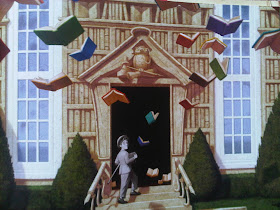It should by now come as no surprise that we at the Jade Sphinx think writer, illustrator and animator William Joyce is a genius. His magnificent drawings and water colors (so evocative of the Golden Age of Illustration), his delicious sense of whimsy, and his uncanny knack for finding the word that is the most fun have positioned him as the pre-eminent children’s entertainer of the early Twenty-First Century. In an age when so much of children’s entertainment is violent or “dark,” the Joycean oeuvre is a welcome shaft of brilliant sunlight in what is often a very shadowy room.
So we approached the book version of Joyce’s Oscar-winning short silent film, The Fantastic Flying Books of Mr. Morris Lessmore, with something bordering on trepidation. (Joyce co-directed the film with Brandon Oldenburg.) Why … when the film was so enthusiastically reviewed in these pages?
My initial hesitation was mainly because of the ambiguous and mystical qualities of the short film. Surely a print version – dependent on text as well as visuals – would rob the story of some of its alchemy?
Well, I’m happy to report that the book version of Morris Lessmore is as beguiling as the video-version and the downloadable app. If anything, the book version is more mysterious than the film version – with ambiguities of equal power and subtlety.
To recap the story – reader Morris Lessmore has his life thrown into chaos by a violent tornado. Walking through the wreckage, he sees the vision of a beautiful girl carried away by books as if lifted by balloons. He enters a magical library, where he spends the rest of his life caring for the books and sharing them with the world. (Visitors to the library enter in black and white and leave in glorious color.) After decades in the library, an elderly Lessmore leaves as a young woman comes to take his place.
While the film is dense with mystical passages, the book provides different conundrums. With snappy pacing and retro visual style, we watch Lessmore spend his life tending books in a massive library. But while he is caring for the books there – and sharing them with people in need of the curative powers of fiction – he also closes each day by writing in his own journal. As Joyce writes, The days passed. So did the months. And then years. When an elderly Lessmore finally leaves to join eternity, he leaves behind him his own book. As Joyce writes, His life was a book of his own writing, one orderly page after another. He would open it every morning and write of his joys and sorrows, of all that he knew and everything that he hoped for. The contents remain a mystery to the reader, but the question must be asked: is the library really a metaphor for our lives, with each book representing every life lived? Or is Joyce saying that each and every life is a book of blank pages, to be filled with deeds good or bad, as our final contribution to the great library of the world? Or is Joyce saying that we must leave books of value (or lead lives of value) for those who will come after us? (A typical Joycean detail is that the top of Lessmore's pen forms a question mark.)
The very malleability of the story is one of its great satisfactions, along with the Joycean habit of including references to beloved pop culture touchstones, including everything from Winsor McCay to Buster Keaton to The Wizard of Oz. It is no wonder that Lessmore spent several weeks on the New York Times bestseller lists – and as the holidays near, it would make an ideal gift to a young person starting on the personal, life-changing journey of reading. The art (in collaboration with Joe Bluhm) is transcendent — a visual feast for young and old alike. More important, after sharing Morris Lessmore with a child (or lucky adult), it is interesting to ask the listener, what do you think it means?
In other Joyce news: two new volumes in his ongoing Guardians of Childhood cosmology are just arriving in bookstores now: Toothiana, Queen of the Tooth Fairy Armies, is a young adult novel, and the picture book The Sandman: The Story of Sanderson Mansnoozie. Expect reviews in the weeks to come.


ReplyDeletethank you for heads up on this book. I have a bunch of grand nieces/nephews that need a copy for Christmas! This was my favorite film of last year, maybe I need a copy of the book for myself as well. One point of clarification please, what do you mean by "in collaboration with Joe Bluhm"? Are some of the illustrations by one, some the other? Are some of the illustrations from the film cells and Joe Bluhm added extra illustrations? Thank you.
Great question -- I should have been more clear. The paintings in the book are by Joyce -- water colors, not photos from the movies. And they look GREAT. The contributions by Bluhm are some connecting, cartoony illustrations of Lessmore, which are equally charming.
ReplyDelete